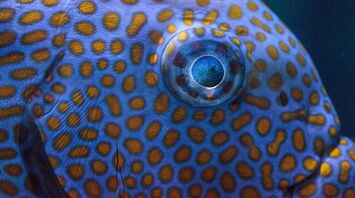Scientists have found out how complex and vivid patterns are formed on animal skin and how it will benefit humans in practice

Patterns on the skin of animals, such as the stripes of a zebra or the colored spots of a poisonous frog, perform various biological functions, including thermoregulation, camouflage, and warning. Their effectiveness depends on a clear separation of colors, the mechanism of which was not clear until recently.
"In a new study," SSPDaily reports, "published in the journal Science Advances, a group of scientists has proposed a potential mechanism for pattern formation. The scientists explained that solving this issue could improve medical diagnostics and the quality of synthetic materials."
What is the problem?
A thought experiment will help you visualize the problem of obtaining characteristic color patterns. Imagine carefully adding drops of blue and red dye to a cup of water. The drops will slowly disperse through the water due to diffusion, where molecules move from an area of higher concentration to an area of lower concentration. Eventually, a uniform concentration of blue and red dyes will form in the liquid and it will turn purple. This is how diffusion helps create color uniformity.
Motion and boundaries
The mathematician Alan Turing first addressed this issue in his 1952 paper "The Chemical Basis of Morphogenesis". Turing showed that, under the right conditions, the chemical reactions involved in creating color can interact with each other in a way that counteracts diffusion. This allows colors to self-organize and create interconnected regions with other colors, forming what are now called "Turing patterns."
However, in mathematical models, the boundaries between color regions are fuzzy due to diffusion unlike in nature, where the boundaries are sharp and the colors are well separated.
Nowadays, scientists who have been working on this problem have come to the conclusion that the key to unraveling the appearance of characteristic color patterns can be found in laboratory experiments with micron-sized particles, cells that are involved in creating the color of an animal's skin.
As a result, experiments have shown that these cells form striped structures when they are placed between an area with a high concentration of other dissolved substances and an area with a low concentration of other dissolved substances.
What is diffusiophoresis and where do we often encounter it?
In the context of our thought experiment, changing the concentration of blue and red dyes in water can cause other particles in the liquid to move in certain directions. When the red dye moves to an area where its concentration is lower, nearby particles will move with it. This is called diffusiophoresis.
By the way, in practice, we encounter diffusiophoresis when we wash laundry. Thanks to this property of matter, dirt particles are removed from clothes as soap molecules are "transported" from the shirt to the water.
Drawing sharp boundaries
In the course of the experiments, the scientists asked whether Turing patterns, which consist of regions of different concentrations, can also move micron-sized particles. If so, would the resulting patterns from these particles be clear rather than blurry?
To answer this question, they conducted computer simulations of Turing patterns such as hexagons, stripes, and double spots, and found that diffusiophoresis makes the resulting patterns significantly clearer in all cases.
Diffusiophoresis simulations made it possible to reproduce complex patterns on the skin of a brightly decorated fish and a pearl moray eel, which is impossible using Turing's theory alone.
Another confirmation of their hypothesis was that the model was able to reproduce the results of a laboratory study of how the bacterium E. coli moves molecular cargo within itself. Diffusiophoresis allowed for clearer patterns of movement, confirming its role as a physical mechanism underlying the formation of biological models.
Since the cells that produce the pigments that make up animal skin color are also micron-sized, the results suggest that diffusiophoresis may play a key role in creating characteristic color patterns on a broader scale in nature.
Learning the tricks of nature
Understanding how nature programs certain functions can help researchers develop synthetic systems that perform similar tasks.
Laboratory experiments have shown that scientists can use diffusiophoresis to create membrane-free water filters and inexpensive tools for drug development.
The results also indicate that combining the conditions that form Turing patterns with diffusiophoresis could be the basis for creating artificial skin. Just like adaptive skin patterns in animals, when Turing patterns change - say, from hexagons to stripes - it indicates underlying differences in chemical concentrations inside and outside the body.
Skin patches capable of sensing these changes could diagnose a medical condition and monitor a patient's health by detecting changes in biochemical markers. They can also detect changes in the concentration of harmful chemicals in the environment.
What should we learn in the near future?
Scientists have modeled exclusively spherical particles, while the cells that form pigments in the skin have different shapes. Today, its influence on the formation of complex patterns remains unclear. This is a task for the near future.
In addition, pigment cells move in a complex biological environment. More research is needed to understand how this environment impedes movement and possibly freezes patterns in place.
In addition to animal skin patterns, Turing patterns play an important role in other processes, such as embryonic development and tumor formation. Our work suggests that diffusiophoresis may play an underestimated but important role in these natural processes.
Ultimately, studying the process of biological pattern formation will help researchers get one step closer to mimicking their functions in the laboratory, which will definitely benefit society.



















